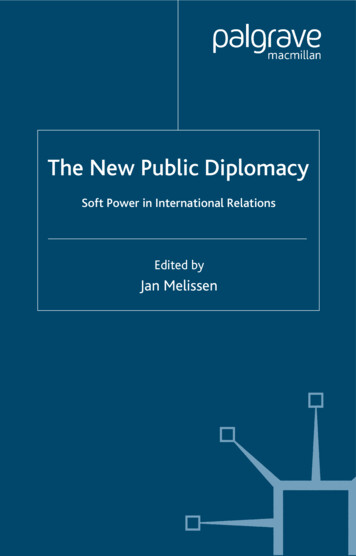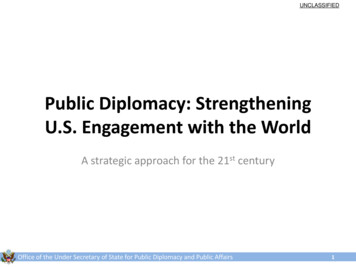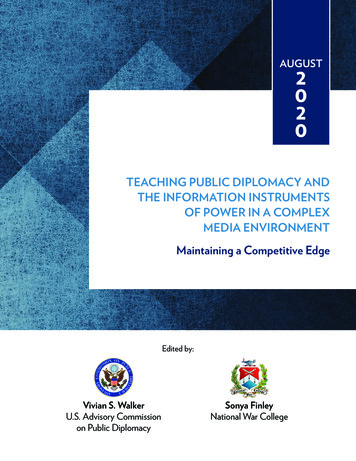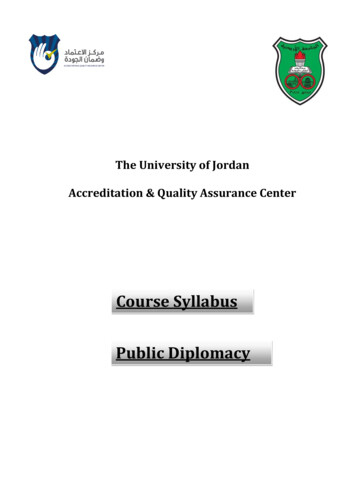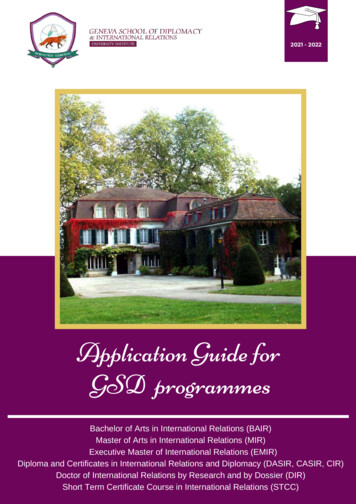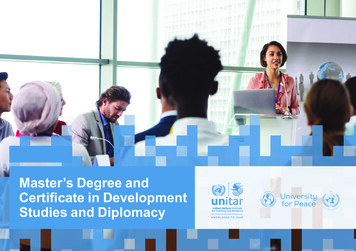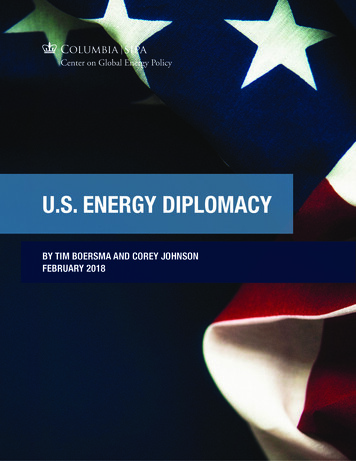
Transcription
U.S. ENERGY DIPLOMACYBY TIM BOERSMA AND COREY JOHNSONFEBRUARY 2018
ABOUT THE CENTER ON GLOBAL ENERGY POLICYThe Center on Global Energy Policy provides independent, balanced, data-driven analysisto help policymakers navigate the complex world of energy. We approach energy as aneconomic, security, and environmental concern. And we draw on the resources of a worldclass institution, faculty with real-world experience, and a location in the world’s finance andmedia capital.Visit us at www.energypolicy.columbia.edu@ColumbiaUenergyABOUT THE SCHOOL OF INTERNATIONAL AND PUBLIC AFFAIRSSIPA’s mission is to empower people to serve the global public interest. Our goal is to fostereconomic growth, sustainable development, social progress, and democratic governanceby educating public policy professionals, producing policy-related research, and conveyingthe results to the world. Based in New York City, with a student body that is 50 percentinternational and educational partners in cities around the world, SIPA is the most global ofpublic policy schools.For more information, please visit www.sipa.columbia.edu
U.S. ENERGY DIPLOMACYBY TIM BOERSMA AND COREY JOHNSONFEBRUARY 20181255 Amsterdam AveNew York NY 10027www.energypolicy.columbia.edu@ColumbiaUenergy
US ENERGY DIPLOMACYACKNOWLEDGEMENTSFor comments on earlier drafts of this working paper, insightful conversations, and editorialguidance, we thank Jonathan Elkind, Antoine Halff, Richard Nephew, Matthew Robinson,Megan Burak, Adrian Lajous, Andreas Goldthau, and three anonymous reviewers.ABOUT THE AUTHORSTim Boersma is a senior research scholar at the Center on Global Energy Policy. Prior tojoining CGEP, Tim was a fellow and acting director of the Energy Security and ClimateInitiative at the Brookings Institution. From 2011 to 2012, he was a Transatlantic Academyfellow in Washington, DC. His research focuses on energy policy coordination, unconventionalnatural gas extraction, gas market integration, liquefied natural gas, and energy diplomacy.Before starting his career in research, Boersma spent five years in the private sector, workingas a corporate counsel to the electricity production sector in the Netherlands. Boersma holdsa PhD in international relations from the University of Groningen.Corey Johnson is associate professor and department head of geography at the Universityof North Carolina at Greensboro. Corey’s research and teaching areas include the politicalgeography of Europe and Eurasia, borders and border security, natural resources and energygeopolitics, and Germany. In 2011–12 he was the Joachim Herz Fellow at the TransatlanticAcademy in the German Marshall Fund of the United States in Washington, DC. Originallyfrom Emporia, Kansas, Corey holds a PhD in geography from the University of Oregon and aBA in geography (honors) and German from the University of Kansas.3 CENTER ON GLOBAL ENERGY POLICY COLUMBIA SIPA
US ENERGY DIPLOMACYTABLE OF CONTENTSAcknowledgements3About the Authors3Executive Summary5Introduction6Changing Energy Landscape and Its Potential Implications for Foreign Policy8Energy Diplomacy in the Department of State13Case Study: Natural Gas in Europe15U.S. Diplomats in the Driving Seat?15Challenges of Supply Diversity16Diplomatic Success in Europe18Discussion and Research Agenda20Notes22ENERGYPOLICY.COLUMBIA.EDU FEBRUARY 2018 4
US ENERGY DIPLOMACYEXECUTIVE SUMMARYThe oil and gas boom has turned the US energy landscape upside down, with ripple effectsaround the world. This transformation has given rise to discussions of how Washington canleverage these newly found riches to its advantage internationally. The emerging literature inthis field seems to agree that major benefits accrue to those nations that produce massiveamounts of hydrocarbons but too often misses a clearly defined starting point for analysis, forinstance regarding the division of labor between public and private actors.The Obama administration was the first to have this “tool” in its diplomatic toolbox and maderepetitive claims about how American resources were going to be used to help allies in, forinstance, Europe. The transition to the Trump administration brought with it numerous policychanges, including on the diplomatic front, though the mantra to “unleash” US resources intothe world has suggested continuity, rather than change, absent the tone of diplomacy.This paper examines the history of US energy diplomacy and how it has been altered by theUS oil and gas boom. It then explores the limitations of US energy diplomacy and providesa case study to illustrate areas where it has come up short and areas where it has foundsuccess. In short, the paper finds the following: While discussions around US energy diplomacy have oftentimes been framed around thebenefits US energy exports can bring to allies and to pushing back against foes, there seemsto be very little evidence that supports the notion that diplomats can exert this kind ofinfluence. Diplomatic objectives are often overwhelmed by energy market realities. The US oil and gassector consists of thousands of companies of vastly different sizes, making independentinvestment decisions based on commodity price expectations—not on diplomatic desires. Whether and when energy resources are sold is determined by a number of factors,including available infrastructure and existing regulatory framework, but the chief factoris price. If making a pro t is the key objective of US companies, and their actions areindependent, it can be no surprise that there are substantial limits to how the US diplomaticcorps can steer the flow of commodity to achieve desired political goals. In specific cases where US diplomats have tried to persuade importing allies to diversifytheir fuel mix, such as natural gas in Europe, that mix has not materially changed. Europeanefforts to increase optionality for various member states have generated meaningful results,even though it is more complicated to declare that an American diplomatic success. It is important to consider energy as just one topic in a broader diplomatic playbook,contrary to what a phrase like “energy diplomacy” may suggest. Our analysis suggests further study to better comprehend the merits of and limitations toUS energy diplomacy is likely valuable but that achieving desired outcomes can be difficultand that its promise to the broader public therefore must be modest.5 CENTER ON GLOBAL ENERGY POLICY COLUMBIA SIPA
US ENERGY DIPLOMACYINTRODUCTIONOver the preceding decade until November 2016, energy came to occupy a more centralposition in the United States’ foreign policy apparatus, and the term “energy diplomacy”became frequently used in policy circles and the media. The reasons for this are numerous,but a 2014 headline from the New York Times captures the essence: “Oil’s Comeback GivesU.S. Global Leverage.”1 Indeed, the unleashing of massive amounts of US unconventionaloil and gas transformed the country from a political and economic superpower that wasrelatively energy poor in relation to its consumption habits into an energy superpower in itsown right. The US energy narrative shifted quickly from talk of scarcity and ever-increasingimport dependence to one of abundance, in which the nation became a major global exporter.For US diplomats, this occasioned the rethinking of what role energy could play in advancingstrategic interests abroad. In October 2012, then secretary of state Hillary Clinton gave a majoraddress at Georgetown University on energy diplomacy in the 21st century, proposing thatenergy could be used to help solve territorial and maritime disputes, promote competition inEurope, get the Republic of Iraq back on its feet, bring peace in the South Sudan and Sudanconflict, and tackle energy poverty and climate change.2 Secretary Clinton’s State Departmentstood up a Bureau of Energy Resources with dozens of diplomats devoted to these topics.At meetings abroad and in Washington, energy was literally on the agenda, assuming a moreprominent role than at any time since the Carter administration.Following the 2016 US presidential election, the talk has changed again. The Trumpadministration has spoken about taking policy steps to unleash American energy and itsbenefits for our allies. In June of 2017, President Trump and several administration officials andsupporters publicly announced that a new era of “energy dominance” was at hand, hailingthe potential of exports of fossil fuels to friends around the world. To give us a flavor of whatdominance looks like, while visiting China in November 2017, President Trump announcedpossible Chinese investments into the US energy and chemicals sector in Alaska and WestVirginia worth dozens of billions of dollars. Whether these memorandums of understandingwill in fact become firm agreements, time will have to tell, yet that nuance likely gets lost onthe broader audience. “Dominance” might also take a more negative connotation in the future,as recent discussions about a possible border tax on energy resources have suggested.3This paper takes stock of US energy diplomacy historically and in the wake of the 2016election and considers the prospects of the concept going forward. The question the paperasks is whether the conventional wisdom suggesting a prominent and growing role of energyin US diplomatic efforts is a valid starting point, given the realities of the US energy sectorand the domestic and global energy markets. It is intended as a first attempt at sketchinga framework for understanding the underlying nuances of US diplomacy in the energyfield, where the possibilities and opportunities for diplomats lie, and where they might beconstrained in a market where, to a significant extent, the private sector beats the drum. Inthe US oil and gas sector, the distinction between public and private actors is quite rigid.Independent—not state owned—energy companies are making investments to developresources. These investments decisions are informed by a myriad of factors, some of whichENERGYPOLICY.COLUMBIA.EDU FEBRUARY 2018 6
US ENERGY DIPLOMACYare controlled by the government (such as tax regimes, concessions, and regulations).However, the most critical signal, whether the price of a commodity creates an incentive toproduce and sell, comes from the market and informs whether investment decisions receivefinancing and can be made.In discussing these issues, this paper begins with an overview of the evolving US energyposture and US diplomacy. We base our analysis on several dozen interviews withstakeholders, ranging from private sector actors, regulators, and scholars to governmentofficials, including (former and current) diplomats. These interviews were conducted basedon anonymity, and we will therefore not provide a list of participants in our research. We thenturn to a case study on natural gas in Europe to help provide a better understanding of thechallenges related to US energy diplomacy, and we identify where US diplomats may benefitfrom enhanced energy extraction and trade and where they may find challenges. We concludewith some brief observations on the current administration, the role that energy diplomacymay play going forward, and how, despite significant political uncertainties, market realitiessuggest that continuity is more likely than radical change. Our analysis suggests that energydiplomacy will, at least rhetorically, occupy a more prominent position in US foreign policythinking but that achieving foreign policy goals using energy diplomacy is far more difficultthan some of the rhetoric has promised.7 CENTER ON GLOBAL ENERGY POLICY COLUMBIA SIPA
US ENERGY DIPLOMACYCHANGING ENERGY LANDSCAPE AND ITSPOTENTIAL IMPLICATIONS FOR FOREIGN POLICYIt is hard to overstate the impact that the US oil and gas boom has had on domestic andglobal markets. Understandably, the availability of large amounts of new resources comeswith a myriad of ripple effects. The dramatic changes in the US energy landscape providedmembers of the US diplomatic corps with a powerful narrative when they engaged with theirpeers around the globe.Various scholars and energy experts have suggested the United States could enjoy importantgeopolitical benefits from increased domestic natural gas and oil production.4 Somecontributions in this genre have even claimed that US authorities should try to proactivelyleverage these resources to the country’s diplomatic advantage.5 These discussions are oftenframed in terms of “helping allies” and “punishing foes” and using US energy diplomacy as ameans to achieve these goals. What is problematic about these contributions is that they failto provide a detailed description of what “energy diplomacy” means and lack a clearly definedstarting point, or framework of analysis. Thus, it sometimes remains vague what governmentagencies can in fact do to “use” those resources to the advantage of the United States.Indeed, in our interviews, we began by asking what US energy diplomacy means. We got asmany different answers as we had interviews. As one respondent noted: “Energy diplomacycan be whatever you want it to be.”In a 2014 testimony, David Goldwyn, who served as the US Department of State’s specialenvoy and coordinator for international energy affairs from 2009 to 2011, gave an overviewof the tools that the US government has at its disposal to mitigate possible energy supplydisruptions, increase energy security, and mitigate the consequences of climate change.6In sum, this includes educating foreign governments and other constituencies (e.g., aboutmarket reform and free trade), providing technical assistance (e.g., sharing best practicesregarding shale gas extraction), and US companies bringing more natural resources intothe global system, thereby putting downward pressure on prices and forcing incumbentsto adapt. Also in 2014, Goldwyn’s successor at the State Department, Ambassador CarlosPascual, used European progress to further integrate its natural gas markets as an exampleof how competition can help relieve countries of the yoke of monopolistic suppliers, in thiscase Gazprom.7 Amos Hochstein, special envoy for international energy affairs from the StateDepartment under former president Obama, became the personification of the US new energyposture. Testifying in front of a House of Representatives subcommittee in 2016, Hochsteinobserved that “the United States has transformed into the world’s energy superpower.”8 Ina separate interview with the Houston Chronicle, Hochstein indicated in reference to Ukrainethat “the idea is to use LNG to free the country from their dependencies.”9 Compare that toDepartment of Energy’s George Person’s Senate testimony from 2005, when conventionalwisdom dictated that US imports of energy resources, including oil and natural gas, weregoing to continuously grow. Against such expectations, Person in his testimony mentionedthat was one of the fundamental principles guiding US foreign policy. In his words, this hadto be interpreted as an “ongoing, quiet dialogue” as “the best vehicle for our interactionwith producing countries, enabling us to frankly exchange views on oil market developmentsENERGYPOLICY.COLUMBIA.EDU FEBRUARY 2018 8
US ENERGY DIPLOMACYand to promote a greater understanding of key issues.”10 Thus, we can observe that within arelatively modest time frame, the US diplomatic corps shifted its modus operandi from quietdiplomacy to openly promoting energy wealth for foreign policy purposes.Hochstein was correct to point to the dramatically changed US energy landscape. While anysuggestion that the United States is a lone energy superpower is probably an overstatement,it is truly one of only a handful of such superpowers (table 1).Table 1: Overview of 2016 world top energy producers and exportersProductRankCountryUnitValueCrude Oil ProductionNo.1Saudi 6No.1USKboe12,354No.2Saudi y72No.2RussiaBcf/day56No.3IranBcf/day20Total oil production (crude NGL)NGL productionNGL exports (gross)Biofuels productionRefinery outputRefined product exports (gross)Natural gas production9 CENTER ON GLOBAL ENERGY POLICY COLUMBIA SIPA
US ENERGY DIPLOMACYProductRankCountryUnitValueCoal productionNo.1ChinaMillion tons3,411No.2IndiaMillion tons692No.3USMillion anTWh50Wind capacityWind power generation (gross)Solar capacitySolar power generation (gross)Source: JODI and BP WEO data.Although the contours of energy diplomacy under the Trump administration are not entirelyclear, we have a broad understanding. Differences with the previous administration do notseem substantial when it comes to oil and gas production and exports. The president hasrepeatedly indicated that he wants to “unleash” US energy resources on the world and benefitfrom increased exports. Yet the Obama administration put in place much of the frameworkthat could help achieve that goal. It was President Obama who streamlined the process tolicense exports of liquefied natural gas to countries without a free-trade agreement (exportsto FTA countries were always less cumbersome) and who made a deal with the US Congressin late 2015 to lift the ban on crude oil exports. Exports of oil products and NGLs were alreadyallowed, though they shot to record highs during the Obama administration on the back ofsurging domestic oil production. How Trump’s anti–free trade posturing will be reconciledwith the fact that trade agreements are an obvious tool to create rules that encourage energyexports remains to be seen. There is some room for the Trump administration to incentivizeoil and gas production on public lands and offshore, and time will tell whether that will have amaterial impact in terms of additional production. However, the fundamental difference withthe previous administration is that Trump dismisses anthropogenic climate change. Doingso in turn allows this administration to be more explicit about the benefits of oil and gasENERGYPOLICY.COLUMBIA.EDU FEBRUARY 2018 10
US ENERGY DIPLOMACYproduction and exports, and to include coal production and exports into that narrative. Thebest illustration of this was the public acclaim of the deal that a Pennsylvania coal companystruck with a Ukrainian utility to export 700,000 tons of US coal to the country to helpproduce electricity and heat homes.11We know that energy will continue to play a role in foreign policy as it has done for manydecades, but possibly in quite different ways than those imagining an energy superpowerexpect. President Trump campaigned on a promise of revitalizing and releasing what he saidwas a regulatory chokehold on the domestic coal industry. Indeed, US foreign policy underPresident Trump has put coal back on the diplomatic agenda, and when Ukraine agreedto import coal (in the absence of options to import natural gas) from the United States toreplace resources from Russia, there was much rejoicing among the shrinking ranks of thosewho believe burning coal is smart.12 While the Paris Agreement is out of favor in Trump’sWashington, that will not keep other countries committed to mitigating climate changefrom bringing up the topic through regular diplomatic channels, requiring if nothing else a“defensive” US energy diplomacy.Separately, it is worth noting that the nature of diplomacy is less nation-state based thanat any time in several hundred years.13 Cities, subnational regions, and a host of civil societyand private sector actors will continue to be active in the diplomacy space, and energyconcerns occupy these players as much as foreign ministries do. Moreover, probably morethan anywhere else in the world, private investors have a significant amount of autonomy,and, as long-term investments are customary to the energy sector, there is reason to questionwhether the rhetoric of US administrations over time should be seen as steering US diplomacybut rather as framing US diplomacy within a context of various moving parts that can only becontrolled to a limited extent.In addition, market realities could conspire to undercut President Trump’s bold rhetoric onunleashing American energy. For example, despite Trump’s highly politicized revival of theCanada–US Gulf Coast Keystone XL oil pipeline that had been axed by President Obama in2015, recent news coverage suggests that owner Trans-Canada is struggling to find sufficientinterested market players, due to changed market conditions. Similarly, efforts to revitalize thecoal industry and increased coal exports face strong headwinds. Houser et al. have shown thatdespite Trump’s rhetoric to the contrary, government policy was not among the key factorscontributing to US coal’s decline.14 Instead, much of the pain the industry faces stems fromstructural trends and competition from rising supplies of low-cost US natural gas. It stands toreason, then, that absent drastic measures such as subsidies, it is unlikely that coal will makethe comeback promised by Trump during the campaign.15All of this points to the considerable limitations facing a government seeking to use energyresources to achieve foreign policy goals and also promoting commercial transactions. Wetentatively conclude this section by observing that the posture of US officials when it comesto energy resources has fundamentally changed, partly but likely not exclusively spurred bythe advent of unconventional oil and natural gas. While during the Obama administration,officials tended to walk a fine line between promoting fossil fuels and mitigating theconsequences of their usage, the agenda of the Trump administration is more straightforward,11 CENTER ON GLOBAL ENERGY POLICY COLUMBIA SIPA
US ENERGY DIPLOMACYat least rhetorically, and aimed at promoting hydrocarbons and reviving the nuclear and coalindustry. As we have hinted at, these ambitions should be assessed within existing marketrealities, which in turn also impact how successful diplomacy can be.ENERGYPOLICY.COLUMBIA.EDU FEBRUARY 2018 12
US ENERGY DIPLOMACYENERGY DIPLOMACY IN THEDEPARTMENT OF STATEThere have been some suggestions that energy diplomacy within the State Department was“invented” in response to a greater international competition for energy resources.16 However,our interviews suggest that it is more accurate to say that the Bureau of Energy Resourceswas created for two chief reasons. First, a highly ambitious secretary of state, Hillary Clinton,and her key advisers had identified energy resources and climate change as key areas for theUnited States to make a profile in, given the rapidly changing (domestic) market realities, andaforementioned changing US energy posture. The second reason was related to more classicalbureaucratic processes, in which certain parts of government felt that tasks related to energydiplomacy were not being fulfilled optimally by existing governance structures, and changesin that structure were therefore deemed necessary. It was for these reasons that activities thathad been historically pursued by departments like Commerce and the international bureauat the Department of Energy (DOE) were now in part taken over by a new bureau within theState Department. But it is worth noting that the international office at DOE remained intactand that the Department of Commerce continued to do its share of commercial interestrepresentation. Within the State Department, there are geographic focus groups in additionto thematic groups, which sometimes causes an overlap of interests. Anecdotal evidencesuggests that at times these various interest groups work well together, but competinginterests and ambitions also can come to the fore.In turn, within the State Department, the Bureau of Energy Resources went through its owndevelopment. Originally labeled the Global Shale Gas Initiative (GSGI), this was designed asa shale gas promotion initiative, then renamed Unconventional Gas Technical EngagementProgram (UGTEP), providing technical expertise to policy makers in other parts of the world,spearheaded and announced by David Goldwyn.17 The agenda of the initiative broadenedover time. Subsequently, Ambassador Carlos Pascual became the special envoy for energydiplomacy. A career diplomat, Ambassador Pascual quickly broadened the focus of theinitiative and moved into various initiatives varying from oil and gas to renewables andefficiency. Amos Hochstein, the last special envoy under President Obama, was very vocalabout European energy security and a proposed pipeline from Russia to Germany calledNord Stream 2. By the end of Obama’s second administration, the bureau counted almost 100energy diplomats, and around the Paris negotiations, a special envoy for climate change, ToddStern; his successor; Jonathan Pershing; and their staff had been merged into the bureauas well.The fate of the bureau came into question after the 2016 US presidential election. A HeritageFoundation blueprint suggested the existence of the energy diplomacy bureau in its currentform had been under discussion.18 However, the July 2017 appointment of John McCarrickas deputy assistant secretary seems to imply that bureaucratic continuity is more likely thanabrupt change. It is also worth keeping in mind that even if the bureau had not survived theTrump administration’s pursuit of “less government,” this would not have to mean the endof energy diplomacy, since other diplomats in the State Department could have continuedtheir work, as could officials in other parts of government. In addition, we should note that13 CENTER ON GLOBAL ENERGY POLICY COLUMBIA SIPA
US ENERGY DIPLOMACYwhile our focus has been on the federal level of government, diplomacy can take place atother levels of government as well. Examples include exchanges of views and best practicesbetween states and/or regulatory authorities and foreign delegations regarding best practicesof shale gas extraction and regulation, and the Global Covenant of Mayors for Climate andEnergy.19 Certainly when it comes to the topic of climate change, it would not be unreasonableto anticipate an increase in diplomatic and advocacy activity to come from levels ofgovernance other than the federal level, given the Trump administration’s stance on the topic.ENERGYPOLICY.COLUMBIA.EDU FEBRUARY 2018 14
US ENERGY DIPLOMACYCASE STUDY - NATURAL GAS IN EUROPEEurope’s dependence on natural gas from Russia has been a regularly debated topic inforeign policy circles in Washington, DC. Government officials have discussed the potentialbenefits and importance of reducing Russia’s dominant role in the European gas sectorsince the Reagan administration, even though at the time these concerns were generallyignored in Western European countries. Arguably, this changed with the 2004 and later 2007expansions of the EU, in which several Central and Eastern European countries and the Balticstates joined. This is because in these countries the notion of energy security has a drasticallydifferent connotation than in their peers in other parts of the EU, based on experiencesof market power abuse and often complicated historical relations with Russia. Additionalconcerns about Europe’s dependence on Russian natural gas came after two major gas supplydisruptions, first in 2006 and later in 2009, which resulted from commercial and politicaldisputes between Russian gas giant Gazprom and Ukrainian gas company Naftogaz. Sincethen, discussions about natural gas have become increasingly securitized and polarized.20Europe’s strategy to deal with dominant gas suppliers rests on several key pillars (i.e., marketliberalization and integration, strengthening the legislative and regulatory framework,supporting market functioning, supply diversification, and moving away from fossil fuelsaltogether). This strategy has received support from Washington. Even though thisstrategy continues to be a work in progress, it has yielded substantial success. By betterinterconnecting national markets, facilitating the free flow of gas across borders, investing inadditional infrastructure to create access to various sources of supply, streamlining nationalregulatory regimes, and creating and strengthening a European regulatory authority, Europehas become a resilient and in large parts increasingly liquid gas market. With 400 millionconsumers, it is also an attractive market where companies want to compete, and thosewho do not play by the rules are challenged in court, as Russian state-owned Gazpromexperienced on multiple occasions as of late. However, one of the key pillars of Europe’sstrategy, namely the expectation that the European market would transform so that dozensof suppliers would compete for clients like the United States, has not materialized. Instead,European gas demand is still met through a combination of domestic supplies and itstraditional major external suppliers, namely Norwegian Statoil, Russian Gazprom, and AlgerianSonatrach in the south, and then volumes of LNG. Indeed, the realities of the European gasmarket have put some European policy makers in an awkward position, certainly since Russiabecame more aggressive in interfering with Ukrainian affairs in 2014. However, despite thatgrowing wedge between the EU and Russia at the political level, these trends do not changethe actual flow of commodity or end long-term offtake agreements. Therefore, in all realisticscenarios, European consumers will
natural gas extraction, gas market integration, liquefied natural gas, and energy diplomacy. Before starting his career in research, Boersma spent five years in the private sector, working as a corporate counsel to the electricity production sector in the Netherlands. Boersma holds a PhD in international relations from the University of Groningen.
